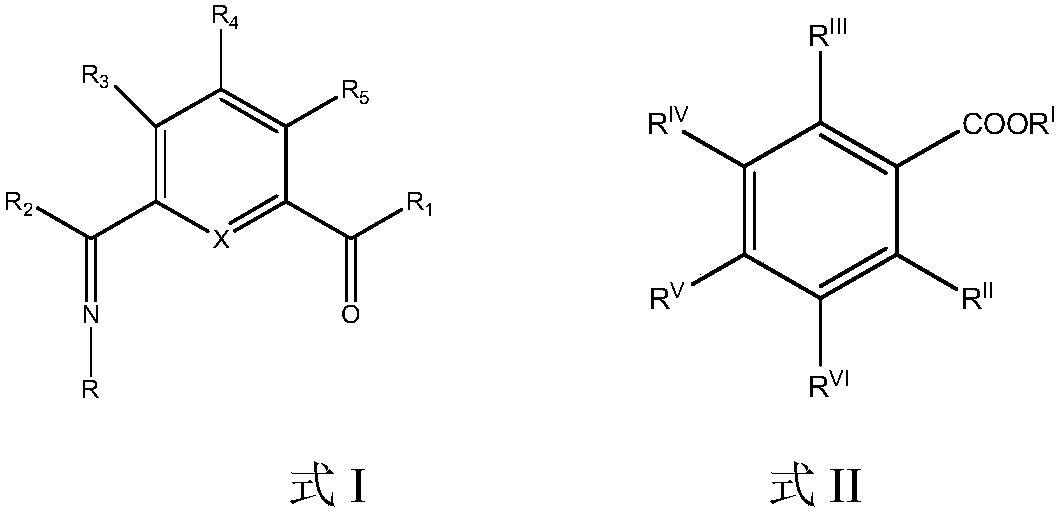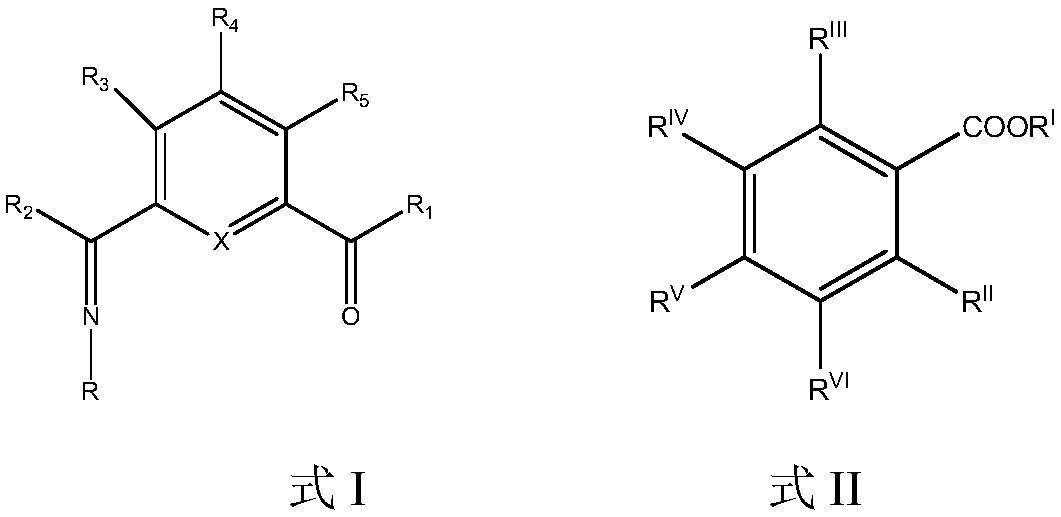Catalyst component and catalyst used for olefin polymerization, and application thereof
A technology for olefin polymerization and catalyst, which is applied in the field of olefin polymerization and can solve problems such as ligand compounds that have not yet been seen
- Summary
- Abstract
- Description
- Claims
- Application Information
AI Technical Summary
Problems solved by technology
Method used
Image
Examples
Embodiment 1
[0048] Synthesis of 6-(phenylimino)ethyl-2-acetylpyridine: In a 250ml three-necked flask, add 3.26g of 2,6-diacetylpyridine, 100ml of isopropanol and 0.2ml of Glacial acetic acid, stirred evenly at room temperature. At room temperature, 1.96 g of aniline dissolved in 20 ml of isopropanol solution was slowly added dropwise. After the addition was completed, the reaction was stirred for 2 hours, and then the temperature was raised to reflux for 12 hours. The reaction solution was concentrated under reduced pressure and separated by column chromatography to obtain 2.83 g (62% yield) of the product. 1 H-NMR (δ, ppm, TMS, CDCl 3 ):8.46~8.42(2H,m,ArH),7.96~7.93(2H,m,ArH),7.32~7.28(2H,m,ArH),7.10~7.06(2H,m,ArH),2.35~2.32( 3H,s,CH 3 ),1.15~1.12(3H,s,CH 3 ); Mass Spectrum, FD-MS: 238.
Embodiment 2
[0050] Synthesis of 6-(4-chlorophenylimino)ethyl-2-acetylpyridine: In a 250 ml three-necked flask, add 1.63 g of 2,6-diacetylpyridine and 80 ml of isopropyl Alcohol and 0.2 ml of glacial acetic acid, stirred well at room temperature. Slowly add 1.27 g of p-chloroaniline dissolved in 20 ml of isopropanol solution dropwise at room temperature, stir and react for 2 hours after the addition, then raise the temperature and reflux for 18 hours. The reaction solution was concentrated under reduced pressure and separated by column chromatography to obtain 1.63 g (69% yield) of the product. 1 H-NMR (δ, ppm, TMS, CDCl 3 ):8.44~8.40(2H,m,ArH),816~8.14(1H,m,ArH),7.46~7.41(2H,m,ArH),7.12~7.08(2H,m,ArH),2.38~2.34( 3H,s,CH 3 ),1.12~1.09(3H,s,CH 3 ); Mass Spectrum, FD-MS: 272.
Embodiment 3
[0052] Synthesis of 6-(2,6-diisopropylphenylimino)ethyl-2-acetylpyridine: In a 250 ml three-necked flask, add 1.63 grams of 2,6-diacetylpyridine, 80 ml of isopropanol and 0.1 ml of glacial acetic acid were stirred at room temperature. 1.78 g of 2,6-diisopropylaniline dissolved in 20 ml of isopropanol solution was slowly added dropwise at room temperature. After the addition was completed, the mixture was stirred for 2 hours and then heated to reflux for 12 hours. The reaction solution was concentrated under reduced pressure and separated by column chromatography to obtain 2.32 g (72% yield) of the product. 1 H-NMR (δ, ppm, TMS, CDCl 3 ):8.45~8.41(2H,m,ArH),7.96~7.92(2H,m,ArH),7.36~7.34(2H,m,ArH),3.22~3.18(2H,m,CH),2.27~2.24( 3H,s,CH 3 ),1.28~1.24(6H,m,CH 3 ),1.14~1.10(6H,m,CH 3 ),1.10~1.07(3H,s,CH 3 ); Mass Spectrum, FD-MS: 322.
PUM
 Login to View More
Login to View More Abstract
Description
Claims
Application Information
 Login to View More
Login to View More - R&D
- Intellectual Property
- Life Sciences
- Materials
- Tech Scout
- Unparalleled Data Quality
- Higher Quality Content
- 60% Fewer Hallucinations
Browse by: Latest US Patents, China's latest patents, Technical Efficacy Thesaurus, Application Domain, Technology Topic, Popular Technical Reports.
© 2025 PatSnap. All rights reserved.Legal|Privacy policy|Modern Slavery Act Transparency Statement|Sitemap|About US| Contact US: help@patsnap.com



